Effect of Thaumatococcus daniellii leaf rat-feed on potassium bromate induced testicular toxicity
CO Nwonuma, EO Irokanulo, CE Iji, OO Alejolowo, CO Adetunji
1Biochemistry Unit, Department of Biological Science, Landmark University, Omu-Aran, Nigeria
2Microbiology Unit, Department of Biological Science, Landmark University, Omu-Aran, Nigeria
Effect of Thaumatococcus daniellii leaf rat-feed on potassium bromate induced testicular toxicity
CO Nwonuma1*, EO Irokanulo2, CE Iji1, OO Alejolowo1, CO Adetunji2
1Biochemistry Unit, Department of Biological Science, Landmark University, Omu-Aran, Nigeria
2Microbiology Unit, Department of Biological Science, Landmark University, Omu-Aran, Nigeria
ARTICLE INFO
Article history:
Received 2016
Received in revised form 2016
Accepted 2016
Available online 2016
Testicular toxicity
Objective:To evaluated the antioxidant and protective effect of Thaumatococcus daniellii (T. daniellii) on rat feed on potassium bromate (KBrO3) toxicity in male rat testes.Methods:Thirty male albino rats of average weight 140±5 g were randomly grouped into 5 with six rats per group. The rats in group A (positive control) and test groups (C, D and E) were orally given 0.5 mL of 10 mg/kg body weight of KBrO3daily. The animals in the negative control (group B) and positive control were fed with commercial rat feed while the animals in the tests groups were fed with 10%, 20% and 30% T. daniellii leaf rat feed respectively. The treatment was carried out for 14 d consecutively, and the animals were sacrificed 24 h after the last day of the treatment.Results:Biochemical assays were carried out on the testicular homogenates. The results showed significant increase (P<0.05) in malondialdhyde, total protein, and superoxide dismutase as well as testicular glycogen in the positive control compared to test groups. The histopathological result showed testicular cellular degeneration in the positive control compared to the test animals which showed normal cell due to protective effect of the leaf.Conclusions:The biochemical and histopathological results in this present study showed testicular toxicity in the rats administered with KBrO3and T. daniellii leaf protective effect on the testicular function toxicity in rats fed with T. daniellii leafrat feed.
1. Introduction
The optimal function of the reproductive system in human is vital for sustenance of life. Infertility is a health problem affecting approximately 15% couples world-wide. It is now evident that in 50% of all cases at least, reduced semen quality contributes to the problem[1]. Some of the reported infertility cases are attributed to low sperm count which could be a result of hormonal imbalance induced by oxidative stress. Recent studies have shown that alterations in the sperm molecular factors (paternal genome, mitochondrial DNA and transcripts) maybe is the underlying cause of infertility[2,3]. Potassium bromate (KBrO3) has been shown to cause oxidative stress in the kidney and liver of rats as well as cell tumours and follicular cell tumours of the thyroid[4]. It also has an adverse effect on the physiological and biochemical functions of Swiss albino rats[5]. Scientific evidence has also implicated KBrO3to be carcinogenic, and has since been removed from the list of acceptable additives for flour treatment[6]. However, under controlled baking conditions, KBrO3is converted into potassium bromide, which is considered to be harmless to the consumer[6]. This salt is now banned in some countries[7], but is still being used in USA and Japan. However, some degree of illegal use of KBrO3in dough preparation is still recorded in countries with a ban on its use apparently, because it is cheap, easily accessible and perhaps the best and most effective oxidizing agent, acting sluggishly through the fermentation period and changing the structure and propertiesof the dough. Some plants’ leaf due to their phytochemical content has the potential to abate or prevent oxidative stress. One of such is Thaumatococcus daniellii(T. daniellii) known as the sweet prayers plant, mainly because its seed is a good sweetener. The sweet prayers’ plant, T. daniellii is a rhizomatous plant found in tropical rain forests and coastal areas of west Africa, particularly, Nigeria, Ghana and Cote d’Ivoire[8]. T. daniellii, whether cultivated or in the wild, contributes to the economy of the rural people in most parts of southern Nigeria through its stalks, leaves, fruits and rhizomes[9]. It is locally used in mat weaving (stalks), roof thatching (stalks and leaves), food wrapping (leaves), as potherbs (leaves and rhizomes) and for sweetening drinks and foods (fruits). The most exciting use of T. daniellii, for which it has earned global interest, is its use as a sweetener and taste modifier[10]. There are unscientific claims that food wrapped with the leaf usually have better taste and prevent food from related poison. The testes of humans and other mammals are highly susceptible to be damaged by genetic disorders, environment or occupational exposure to chemical or other means. Specific causes of testicular damage have been catalogued[11]. Reports on the abatement of KBrO3induced toxicity in rats through compounded feed is scanty. This study has therefore, evaluated the effect of KBrO3in some selected testicular function indices and abetment by T. daniellii rat feed on the adverse effect of the substance on rats’testicular function.
2. Materials and methods
2.1. Preparation of plant material and feed compounding
The leaves of T. daniellii were purchased at Oja-Tutu market at Ilorin Kwara State Nigeria and authenticated at the Department of Plant Biology University of Ilorin. The leaves were washed under running water, air-dried and pulverised. The pulverised leaves were filtered. Each of the rats in this experiment was fed 9 g daily ratio of feed. The preparation of the feed was as follow: 10%, 20% and 30% rats’ daily ration were substituted with 10%, 20% and 30% pulverised T. daniellii leaves respectively at the ratio of 1:4 (w/w).
2.2. Preparation of the KBrO3
0.5 mL of 10 mg/kg body weight of KBrO3was orally administered daily to the rats through gavage during the experiment. The selection of KBrO3dosage was premised upon our previous findings[12] which showed that 10mg/kg body weight of KBrO3caused testicular damage.
2.3. Animal grouping and treatment
Thirty male Wistar albino rats of average weight of 140±5 g were randomly assigned into 5 groups A, B, C, D and E. Group A and B were the positive and negative control respectively while C, D and E were the test groups. Rats in Groups A, C, D and E were all administered 0.5 mL of 10 mg/kg body weight of KBrO3daily dose. Subsequently, the rats in test groups C, D and E were fed 10%, 20% and 30% of T. daniellii rat feed respectively. Rats in groups A and B were fed commercial rat feed only. All the animals were allowed access to drinking water ad-libitum. The treatments were consistent each day for 14 d.
2.4. Preparation of testicular homogenate
The testes were harvested from the sacrificed rats and immediately homogenized in ice-cold 0.25 mol/L sucrose solution using a mortar and pestle placed on ice to reduce heat generated from the friction between the mortar and pestle. The homogenates were diluted in 1:5w/v ratio. The homogenates were then centrifuged at 5 000 r/min for 15 min. The supernatants were collected into clean sample bottles and kept frozen until required for biochemical assays.
2.5. Biochemical assay
Digital UV/VIS spectrometer was used to investigate the biochemical parameters in the rats’ testicular homogenate. Total protein concentration in the testicular homogenate was estimated according to the method described by Gornall et al. 1949[13]. The enzyme activities of alkaline phosphatase (ALP), acyl carrier protein (ACP), and superoxide dismutase (SOD) were estimated by the methods described by Wright et al. 1972[14], and Misra et al. 1972 [15] respectively. The level of sialic acid, reduced glutathione, cholesterol and glycogen in the testes were evaluated according to the methods described by Warren et al. 1959[16], Jollow et al.1974 [17], Fredrickson et al. 1987[18] and kemp et al. 1959[19] respectively. Thiobarbituric acid reactive substances (TBARS) was measured as an estimate of malondialdhyde (MDA) which is a product of lipid peroxidation using the method described by Satoh[20].
2.6. Histology of testes
The preparation of tissues for histological examination was carried out as described by Adeyemi et al. [21] The representative portions of the testes removed from sacrificed rats were fixed in 10% buffered formalin (pH 7.4) for 12 h, and then embedded in paraffin. The paraffin embedded tissues were cut into 5 μm sections using a microtome and then stained with hematoxylin and eosin and mounted in Canada balsam[22]. The stained sections were viewed under light microscope and were captured using Sony DSC-W35.
2.7. Statistical analysis
The data were expressed as mean±SEM. Two ways analysis of variance was used followed by Duncan post hoc mean comparison test to assess for significant differences among the variables at P-value less than 0.05. All the statistical evaluations were carried out using the statistical package for social science (SPSS version 19)
3. Results
The percentage organ body weight of testes of the rats in the positive control group showed a significant decrease (37.6%) when compared to the percentage organ body weight of the testes of the rats in the test group fed with 10%, 20% and 30% of the T. daniellii leaf which showed an increase (2.4%, 28.8% and 8.8% respectively) (Figure 1). ACP activity in the positive control animals was elevated (46%) when compared to the test groups fed with 20% and 30% of T. daniellii leaf rat feed which showed a decrease in ACP activity ( 27% and 32.5% respectively) (Figure 2A). On the contrary, the ALP activity in the positive control was decreased significantly (4.5%) when compared with the groups fed with T. daniellii leafrat feed which showed an increase in ALP (109% and 40.9%) (Figure 2B). There was a significant decrease in the total protein concentration in the positive control animals (14.9%) compared to the group fed with 30% T. daniellii leaf rat feed which showed an increase in total protein concentration (3.9%) (Figure 2C). The testicular cholesterol level in the positive control showed a decrease (26.7%) compared to the test groups animals which were fed T. daniellii leaf rat feed, which also showed a reduction (22.7%) (Figure 3A). Similarly, testicular glycogen in rats fed 20% and 30% T. daniellii leaf rat feed showed decrease (3.25% and 11.23%) in comparison with the result obtained for the positive control which also was reduced (59.4%) (Figure 3B). The level of sialic acid showed a significant increase in group fed 30% T. daniellii leaf rat compared to the positive control (Figure 3C). Rats in the control group showed a significant increase in the MDA level (21.82%) when compared to the test group which showed a decrease in MDA (7.41%) in the group fed 20% T. daniellii leaf rat (Figure 4A). GSH level increased significantly in the positive control group compared to the groups fed 10% and 20% T. daniellii leaf rat feed (5.12% and 5.98%), conversely the rats fed 30 % T .daniellii leaf rat feed showed a significant increase in the level of glutathione reductase (52.14%) (Figure 4B). SOD enzyme activity decreased significantly (57.1% ) in the positive control rats compared to the test animals fed 10% and 30% T. daniellii leaf rat feed which showed an increase in SOD activity (85% and 795%) respectively (Figure 4C). The histopathological result of the testes of the animals fed with 10% of the T. daniellii leaf showed well differentiated germ cells and increased proliferation of the sperm cells compared to the positives control animals which showed reduced sperm cell and degeneration of the testicular tissue (Figure 5).
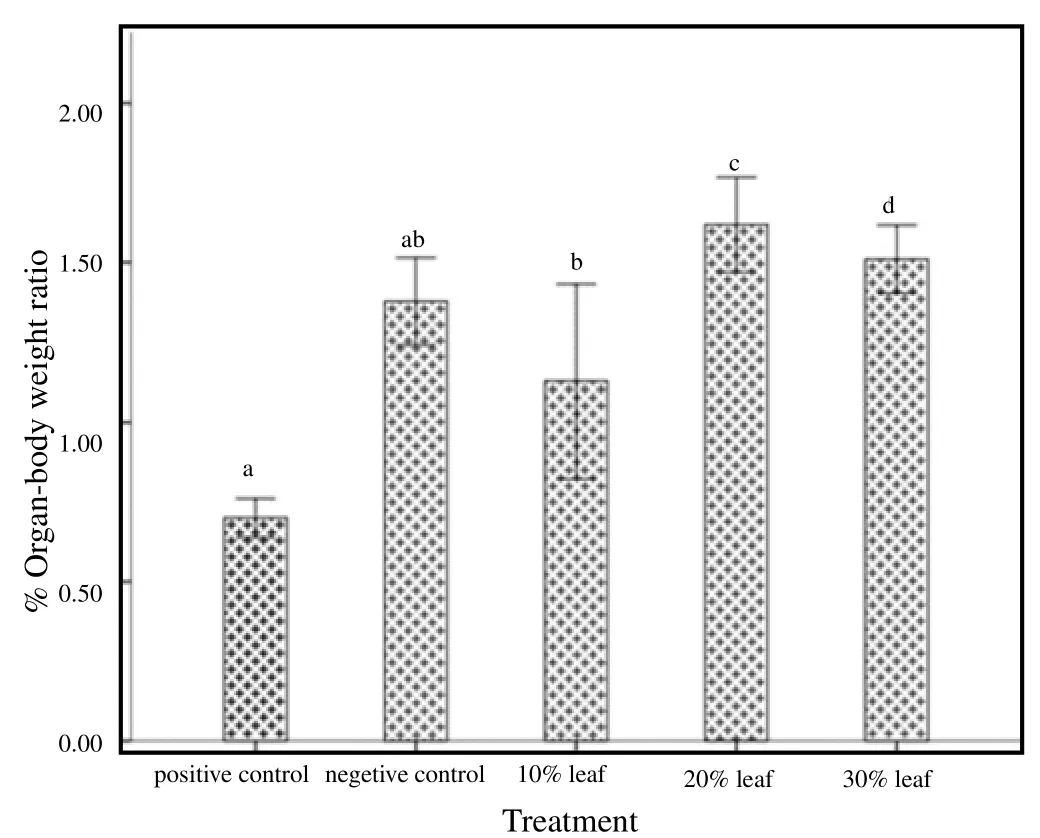
Figure 1. The organ-body weight ratio of rats administered with KBrO3and fed with T.daniellii leaf.
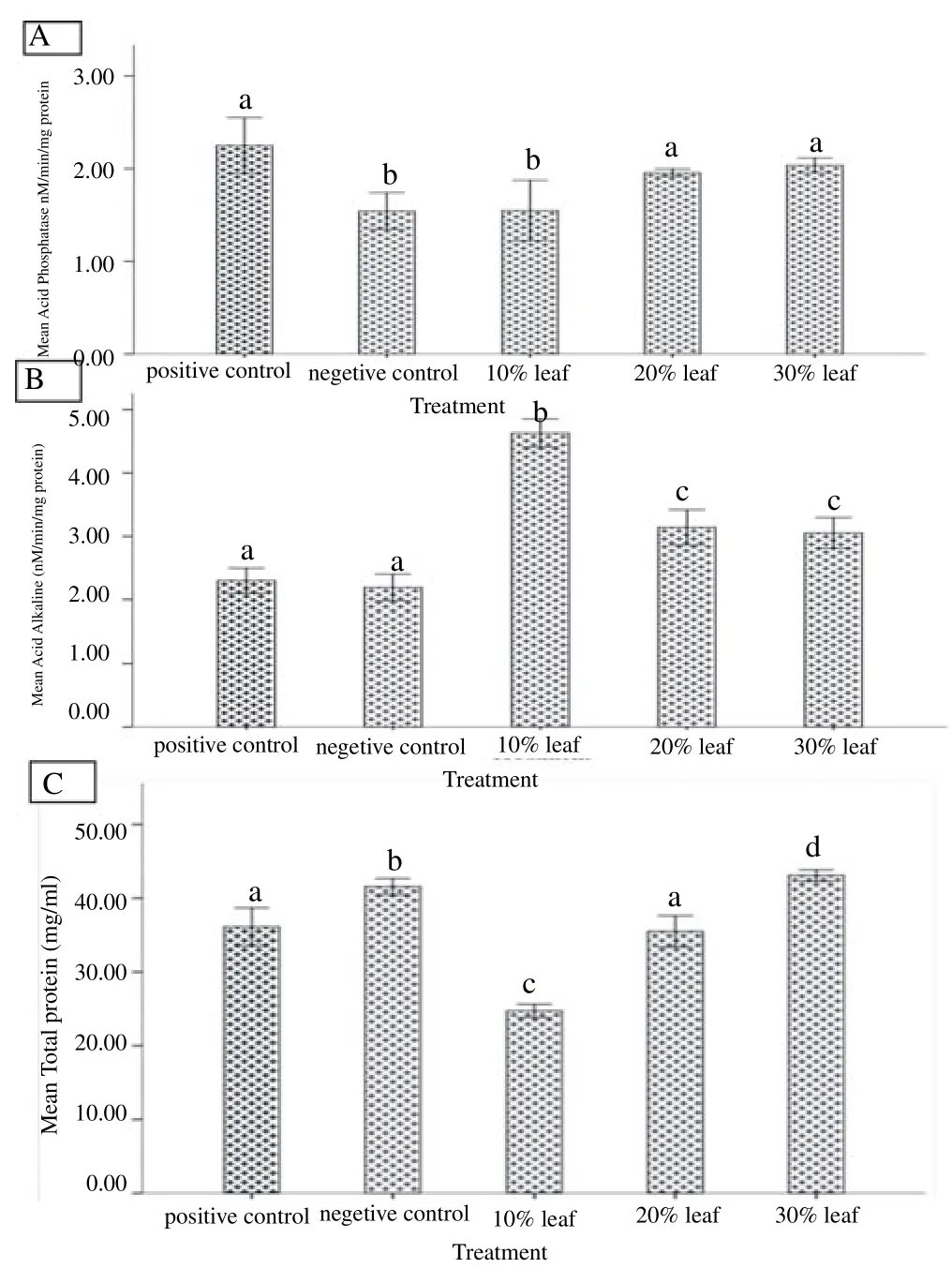
Figure 2. (A-C) The levels of Acid phosphatase (A), Alkaline phosphatase and Total protein (C) in the testes of rats administered with KBrO3and fed with T.daniellii leaf rat-feed.
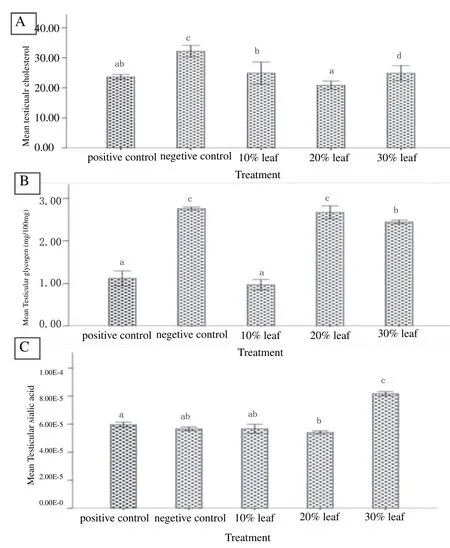
Figure 3. (A-C) The levels of Cholesterol (A), Glycogen (B) and sialic acid(C) in the testes of rats administered with KBrO3and fed with T. daniellii leaf rat- feed.
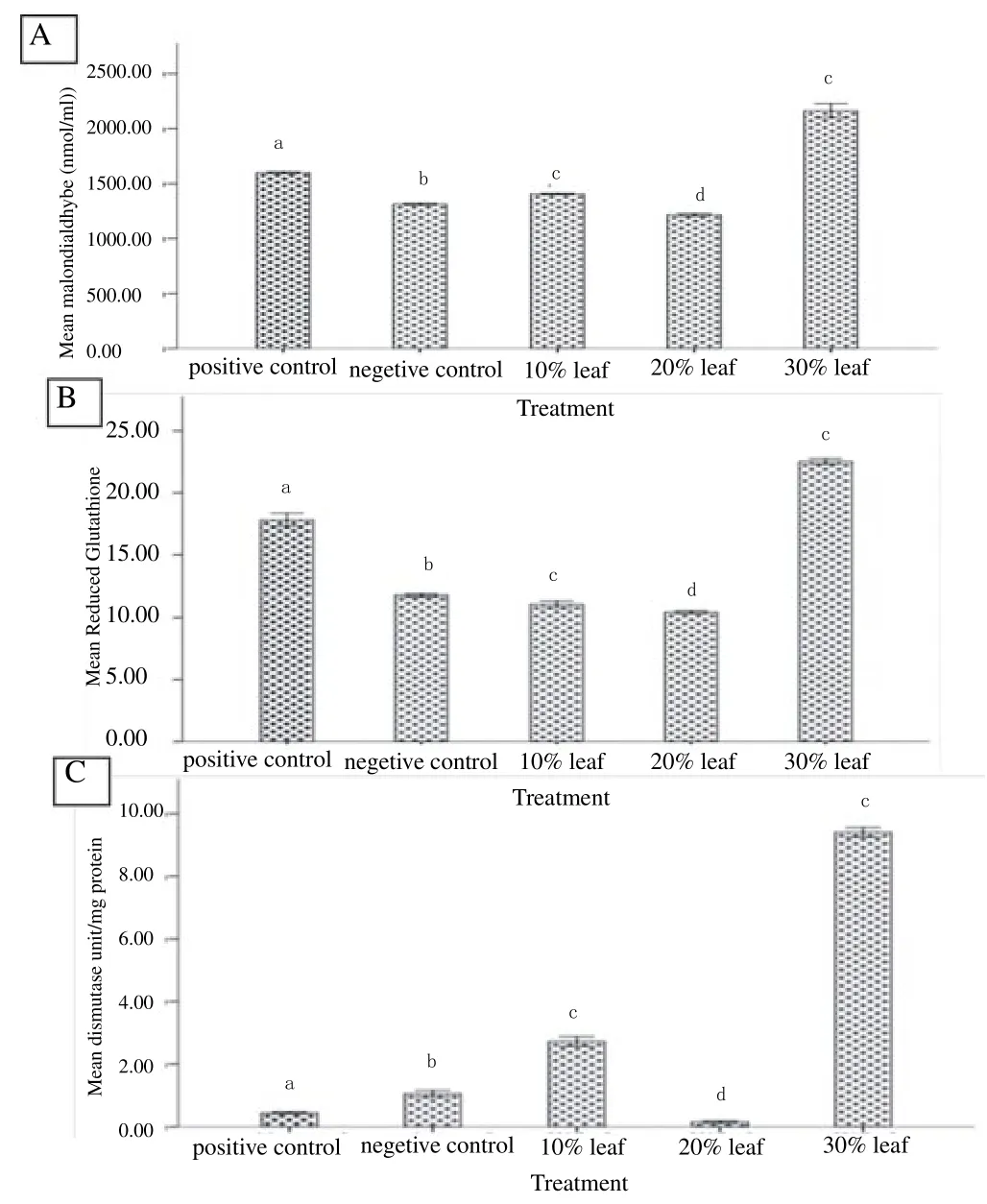
Figure 4. (A-C) The levels of malondialdhyde (A), Glutathione reductase (B) and superoxide dismutase(C) in the testes of rats administered with KBrO3and fed with T.daniellii leaf rat-feed. Each value is represented as mean of three replicates±SEM. abcdeStatistical difference relative to positive control at P ≤ 0.05.
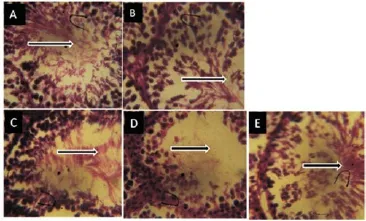
Figure 5. A-E photomicrograph of testis section (H&E ×400)
4. Discussion
The significant reduction in the organ body ratio of the testes of rats fed with KBrO3may be due to KBrO3induced toxicity. This reduction could be as a result of reduced tubule size, spermatogenic arrest and inhibition of steroid biosynthesis of leydig cells, a site of steroid biosynthesis[23,24]. In addition, this may also be an indicative of impairments at testicular, pituitary or hypothalamic level[25]. The increase in organ body weight in the test groups, therefore presupposes that T. daniellii leaf rat feed may have accorded the rat testes protection from the toxic effect of KBrO3. Acid phosphatase is an enzyme (hydrolase), which catalyses the hydrolysis of various phosphate esters with pH-optimum in the acid zone[26].The prostatic isoenzyme of ACP is a vital diagnostic marker of testes. ACP is localized in cellular lysosome consequently compromised to the membrane integrity due to lipid peroxidation may result in the testicular increase in the enzyme. The increased testicular activity may be due to lysosomal membrane breakdown and the liberation of the enzyme by KBrO3[27,28]. The increased activity in the enzyme could also be due to the synthesis of new lysosome as a consequence of lipid peroxidation[29]. The ACP activity in rats fed 10% T. daniellii leaf showed improvement which could be due to the effect of the leaf. ALP is an excellent histochemical as well as biochemical marker for the germ cells of several mammalian species including rats[30]. ALP is primarily of testicular and epididymal origin and, therefore, suitable for differentiation of oligo-and azoospermia [30,31]. The acrosomic system of sperm head is composed of ALP[32] hence any decrease in sperm cells will lead to decrease in the level of ALP activity. The decreased ALP activity seen in the positive control rats may be indicative of reduced spermatogenesis, resulting from a reduction in the number of sperm cells. The decreased ALPactivity could be correlated to decreased acrosomic heads of the sperm cell. Rahman et al. [33] suggested that the decrease in the activities of ALP and ACP in different tissues might be due to the increased permeability of plasma membrane or cellular necrosis in treated animals. Protein biosynthesis is vital in the testicular development and spermatogenesis. Sertoli cells coordinate the spermatogenic process by synthesizing a variety of proteins required during the different phases of germ cell maturation[34]. The increased testicular protein in the animal fed 30 % T. daniellii leaf rat feed could be associated to the protective effect of the leaf. The reduction in protein content observed in the positive control group could also be attributed to disturbances in protein synthesis or metabolism due to toxicity by KBrO3[35]. For the normal testicular activity, testicular cells require cholesterol for membrane biogenesis and cell signalling as well as precursor required for androgen synthesis[36]. It is apparent from this study that KBrO3is responsible the reduced cholesterol level seen in the animals in the positives control, however the increased testicular cholesterol level in the rats fed T. daniellii rat leaf was indicative of the protective property of the leaf on the testicular cells. The energy storage of testicular glycogen is a crucial requirement for gonadal maturation and proper functioning[37]. The decreased testicular glycogen may be due to loss of sertoli cell as a result of degeneration or inhibition of enzyme activity in the synthesis of glycogen. The increase in the glycogen concentration in the test compared to the positive control could be indicative of the abetment effect of the T. daniellii leaf in the compounded feed. Sialic acid (N-acetylneuraminic acid), a derivative of N-acetylmannose and pyruvic acid is an important constituent of glycoproteins and glycolipids. Mann[38] reported that declined sialic acid level may be due to decrease in the rate of spermatogenesis. This study showed increased level of sialic acid in the group fed 30% T. daniellii leaf rat fee which may implied that the leaf have the potential to enhance the testicular synthesis of sialic acid. MDA is an index of oxidative damage to cellular structures[39]. The protection of the leaf against lipid peroxidation was appreciable at the lower percentage of the leaf in the compounded feed, which showed lower MDA concentration compared to the positive control. The low MDA supported the speculation that the leaf has antioxidant property. Glutathione deficiency can lead to instability of the mid-piece of sperm, resulting in defective sperm motility. It protects plasma membrane from lipid peroxidation, scavenges superoxide and prevents O2formation[40]. The increase in the GSH may be because of enhanced synthesis due oxidative stress by KBrO3in the positive control and the group fed 30% leaf. Since GSH level decreased in rats fed lower concentration of the leaf but increased in those given 30% or higher concentration of the leaf, it means that the concentration above 20% may be deleterious rather than protective for the animal. However, the GSH level in the group fed 10% and 20% of the leaf respectively showed protective effect of the leaf against oxidative stress by the KBrO3. The decrease in the activity of SOD in rats in the positive group may be in tandem with the effect of KBrO3in obstruction of metabolism or displacement of Zn and Cu ion which are the cofactor of the enzyme[41]. The increase in SOD activity in the rats fed 30% of T. daniellii-rat feed may be due to induction in the activity of the enzyme activity by the leaf. The histopathological changes in the testicular cells in this study supported the biochemical changes due to KBrO3induced toxicity on the testes function indices. Testicular cell degeneration was very obvious in the positive control which was due to toxicity of KBrO3. The reduced cellular degeneration in the groups fed with T. daniellii rat feed could be indicative of the protective property of T. daniellii leaf. The degeneration could be as a result of KBrO3induced lipid peroxidation on the testicular cell membrane. The biochemical and histopathological results in this study showed KBrO3induced testiculartoxicity in the rats’ testes and protective property of T.daniellii leaf rat feed on the testicular functions of rats administered with KBrO3.
Conflict of interest statement
The authors declare that they have no conflict of interest.
[1] Mishra SS, Kumar S, Singh G, Mohanty K, Vaid S. Oxidative DNA damage in male germ cells in normozoospermic infertile men: A case for concern. Austin J Reprod Med Infertil 2015; 2 (3): 1017.
[2] Kumar K, Deka D, Singh A, Chattopadhyay P, Dada R. Expression pattern of PRM2, HSP90 and WNT5A in male partners of couples experiencing idiopathic recurrent miscarriages. J Genet 2012; 91: 363-366.
[3] Shamsi MB Govindaraj P, Chawla L, Malhotra N, Singh N, Mittal S. Mitochondrial DNA variations in ova and blastocyst: implications in assisted reproduction. Mitochondrion 2013; 13: 96-105.
[4] Kurokawa Y, Maekawa A, Takahasi M, Hayashi Y. Toxicity and carcinogenicity of KBrO3-a new renal carcinogen. Environ Health Perspect 1990; 87: 309-335.
[5] Maria S, Doris D.Effects of potassium bromate on the kidney and haematological parameters of swiss albino rats. Bioscan 2013; 8(3): 1011-1014.
[6] Osemeobo JG. Living on wild plants: Evaluation of the rural household economy in Nigeria. Cambridge J 2005; 7: 246-256.
[7] Ekop AS, Obot IB, Ikpatt EN. Anti-Nutritional factors and KBrO3content in bread and flour samples in uyo metropolis. NigerE-J Chem 2008; 5(4): 736-741.
[8] Yeboah SO, Hilger TH, Kroschel J. Thaumatococcus danielli (Benth): A natural sweetener from the rain forest zone in West Africa with potential income generation in small scale farming. J Applied Sci 2003; 6: 854-859.
[9] Arowosoge OGE, Popoola L. Economic analysis of Thaumatococcus danielli (miraculous berry) in Ekiti State. Nig J Food Agric Environ 2006; 41: 264-269.
[10] Zemanek, EC, Wasserman BP. Issues and advances in the use of transgenic organisms for the production of thaumatin, the intensely sweet protein from Thaumatococcus danielli. Crit Rev Food Sci Nutr 1995; 35: 455-466.
[11] Jadaramkunti UC, Kaliwal BB.Dicofol formulation induced toxicity on tests and accessory reproductive organs in albino rats. Bull Environ Contam Toxicol 2002; 69: 741-748.
[12] Nwonuma CO, Irokanulo EO, Owa OS, Ucheabba DE. Protective potentials of brown chicken eggshell against potassium bromate effect on testicular functional indices in wistar rats. Am J Bio Sci 2015; 3(5): 183-189.
[13]Gornall AG, Bardwawill CJ, David MM. Determination of serum proteins by means of the biuret reaction. J Bioll Chem 1949; 177(2): 751-766. [14] Wright PJ, Plummer DT, Leathwood PT. Enzyme in rat urine alkaline phosphatise. Enzymologia 1972; 42: 317-327.
[15] Misra HP, Fridovich I. The role of superoxide anion in the autoxidation of epinephrine and a simple assay for superoxide dismutase. J Biol Chem 1972; 247(10): 3170-3175.
[16] Warren L. The thiobarbituric acid assay of sialic acids. J Biol Chem1959; 234: 197-1975.
[17] Jollow DJ, Mitchell JR,Zampaglione N, Gillete JR. Bromobenze induced liver necrosis: protective role of glutathione and evidence for 3,4 bromobenzene oxide as the hepatotoxic metabolite. Pharmacology 1974; 11: 151-169.
[18] Fredrickson DS, Levy R1, Lees RS. Fat transport in lipoproteins-an integrated approach to mechanisms and disorders. Nutr Rev 1987; 45(9): 271-273.
[19] Kemp A,Adrienne JM, Heijningen KV. A colorimetric micro-method for the determination of glycogen in tissues. Biochem J 1954; 56: 646-648.
[20] Satoh K. Serum lipid peroxide in cerebrovascular disorders determined by a new colorimetric method. Clin Chim Acta 1978; 90: 37-43.
[21] Adeyemi OS, Akanji MA. Psidium guava leaf extract; effects on rats’serum homeostasis and tissue morphology. Comp Clin Pathol 2010; 11(6): 2.
[22] Galigher AE, Kayloff EN. Essentials of practical microtechniques. Lea and Febiger 1964; 12(2): 77.
[23] Sujatha R, Chitra KC, Latchoumycandane C, Mathur PP. Effect of lindane on testicular antioxidant system and steroidogenic enzymes in adult rats. Asian J Androl 2001; 3: 135-136
[24] Kaur C, Mangat HK. Effects of estradiol dipropionate on the biochemical composition of testes and accessory sex organs of adult rats. Andrologia 1980; 12(4): 373-378.
[25] Chitra KC, Latchoumycandane C, Mathur PP. Chronic effect of endosulfan on the testicular functions of rat. Asian J Androl 1999; 1: 203-206.
[26] Miteva R, Zapryanova D, Fasulkov IV, Yotov S, Mircheva T. Investigations on acid phosphatase activity in the seminal plasma of humans and animals. Trak J Sci 2010; 8(2): 20-23.
[27] Samarth RM, Goyal PK, Kumar A. Indian J Exp Biol 2001: 39: 479-482.
[28] Madhu K, Mukesh KS, Preeti SS, Ashok K. Radioprotective effect of panax ginseng on the phosphatases and lipid peroxidation level in testes of Swiss albino mice. Biol Pharm Bull 2003; 26(3): 308-312.
[29] Rene AA, Dorden JH, Parker JL. Lab Invest 1971; 25: 230-233.
[30] Turner RMO, McDonnell SM. Alkaline phosphatase in stallion semen: Characterization and clinical applications. Theriogenology 2003; 60: 1-10.
[31] Turner RM, Sertich PL. Use of alkaline phosphatase activity as a diagnostic tool in stallions with a zoospermia and oligospermia. Anim Reprod Sci 2001; 68: 315-316.
[32] Ortavant R.Reproduction in domestic animals. Vol. II, Eds. Cole and Cupps, NY, 1959.
[33] Rahman MF, Siddiqui MKJ, Jamil K. Acid and alkaline phosphatase activities in a novel phosphorothionate (RPR-11) treated male and female rats. Evidence of dose and time-dependent response. Drug Chem Toxicol 2000; 23: 497-509.
[34] Weinbauer GF, Luetjens CM, Simoni M, Nieschlag E. Physiology of testicular function. In: Nieschlag, editor.Andrology. Berlin: Springer Berlin Heidelberg; 2010, p. 11-59
[35] Geeta P, Gyan CJ. Assessment of molybdenum induced alteration in oxidative indices, biochemical parameters and sperm quality in testis of wistar male rats. Asian J Biochem 2015; 10(6): 267-280
[36] Hu JZZ, Shen WJ, Azhar S. Cellular cholesterol delivery, intracellular processing and utilization for biosynthesis of steroid hormones. Nutr Metab 2010; 1(7): 47.
[37] Datta KM, Dasgupta J, Sengupta De T, Sengupta S. Glycogen metabolism in human fetal testes. J Biosci 1988; 13: 117-121.
[38] Mann T. Biochemistry of the semen and the male reproductive tract. London, MA: John Wiley and Sons; 1964, p. 391-392.
[39] Sharma RK, Agarwal A. Role of reactive oxygen species in male infertility. Urology 1996; 48: 835-850.
[40] Lushchak VI. Glutathione homeostasis and functions: Potential targets for medical interventions. J Amino Acids 2012; 10: 1155-736837
[41] Nehru B, Anand P. Oxidative damage following chronic aluminium exposure in adult and pup rat brains. J Trace Elem Med Biol 2005; 19: 203-208.
ment heading
10.1016/j.apjr.2016.10.014
*Corresponding author: CO Nwonuma, Biochemistry Unit, Department of Biological Science, Landmark University, P.M.B. 1001, Omu-Aran, Nigeria Omu-Aran, Nigeria. Tel: +2348062624626
E-mail: charlesdetermination@gmail.com
KBrO3
Thaumatococcus daniellii
Albino rats
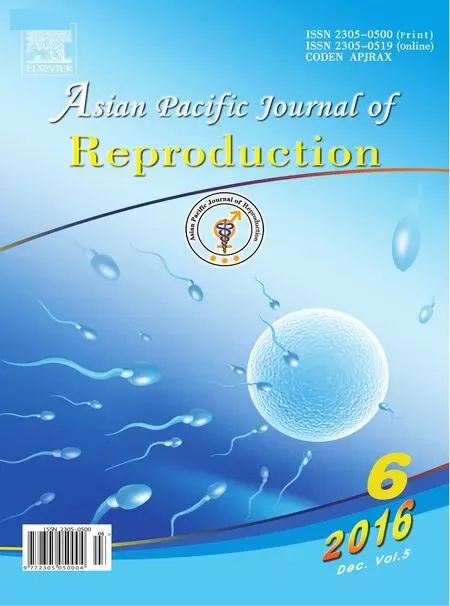 Asian Pacific Journal of Reproduction2016年6期
Asian Pacific Journal of Reproduction2016年6期
- Asian Pacific Journal of Reproduction的其它文章
- The effect of freeze-drying media and storage temperature on ultrastructure and DNA of freeze-dried buffalo bull spermatozoa
- Prolificity of Portuguese Serrana Goats between 1987 and 2015
- Substitution of egg yolk with different concentrations of soybean lecithin in trisbased extender during bulls' semen preservability
- Ultra-structure of testes of rats born to dams treated withhydroxy-progesterone hexanoate
- Hormonal changes and spermatogenesis of male rat puppies born by mothers consuming soybean extract
- Nicotine effect toward the oocyte level of rats(Rattus novergicus)
